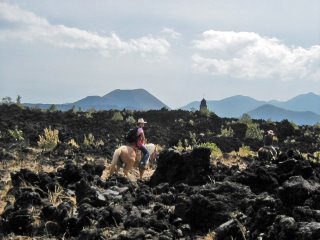
Last month we went on a short road trip inland to the mountains. We stayed in a cabin on Lake Zirahuen. Here is a link to the place http://www.zirahuen.com.mx/ it was great! We stayed in one of the ¨resedential´cabins. Lots of fireplaces and a to die for view of the lake. I can´t believe that i don´t have a photo of that! Anyway the photo that you see here is when we went down lakeside to go `fishing`not alot of fishing was done but it was just great to hang out in the cool air and be on vacation!
The next day we drove over to the volcano Paricutin. It was about an hour and a half from the lake and kind of a long and windy drive. There are quite a few places to stay along the road from Uruapan to Anguahuan the village that is the closest to the volcano, that i imagine would be nice and shorten the trip. We were met at the edge of town by some guys on horses, and since we had heard of the horse thing we hooked up with them. They then galloped beside our cars to the parking lot. It certinaly would have been possible to ignore these guys and go directly to the trail head where there are other horse people to choose from. But in the end they all looked pretty much the same.
We got great horses and had a wonderful day. It took about 1 and a half hours to get to the church that you see in the photo below. We went through pine forests and then over the lava flow. There was only one other group of people on the volcano that day. It was perfect.
The lava flow was impressive. Apparently it covered the town compleatly. No one dies however. How cool is that!? Only the church remains, and much is made of the fact that the lava stopped at the altar.....
Below is the story of the erruption that i got from Bruce Wippleman at his site: http://www.planeta.com/planeta/98/0898paricutin.html. There is lots more information there. I just thought the story was neat.
Dionisio Pulido's Story:
On the afternoon of 4 March 1943, campesino Dionisio Pulido was the first person to witness the birth of a live volcano and live to tell the tale. He said that, around three in the afternoon, he was plowing his field with his yoke of bullocks, when the earth beneath his feet began to shift, shudder, and roar.
 Soon steam began rising from the animals' hoofprints. When Dionosio grabbed his hoe and desperately tried to fill the steamy holes, more holes appeared. His wife arrived with a dozen villagers, who worked like demons with sticks, hoes, shovels, and picks, struggling to fill the ever-widening hot fissures. But it was no use; a terrifying fiery explosion blew huge rocks into the air, and most people simply knelt down in the field, weeping and praying.
Soon steam began rising from the animals' hoofprints. When Dionosio grabbed his hoe and desperately tried to fill the steamy holes, more holes appeared. His wife arrived with a dozen villagers, who worked like demons with sticks, hoes, shovels, and picks, struggling to fill the ever-widening hot fissures. But it was no use; a terrifying fiery explosion blew huge rocks into the air, and most people simply knelt down in the field, weeping and praying.Over the next few weeks, the smoke and explosions gradually became more violent. People ran for their lives as choking ash blanketed their fields and red-hot boulders rained down for half a mile around. Within six months, lava began oozing from the crater and formed huge flows 10 feet deep that burned the forest and buried the villages of Paricutin and San Juan Parangaricutiro, including their church.
When Volcan Paricutin's fires finally sputtered out on 4 March 1952, a grand 10,000-acre moonscape of burnt embers and hardened lava lay at the foot of a dark cinder mountain nearly a third of a mile in height. The entire displaced population of both villages were resettled in a new town, San Juan Nuevo Parangaricutiro, where the people rebuilt their church, six miles west of Uruapan.
Local resident Simon L. Jimenez heard Dionisio tell his story scarcely two days after the volcano had burst from the ground beneath his feet. Jimenez later related the story in his 1993 book, Paricutin, Fifty Years After Its Birth.
Excerpted from Pacific Mexico Handbook by Bruce Whipperman, Moon Travel Handbooks, 1997.

No comments:
Post a Comment